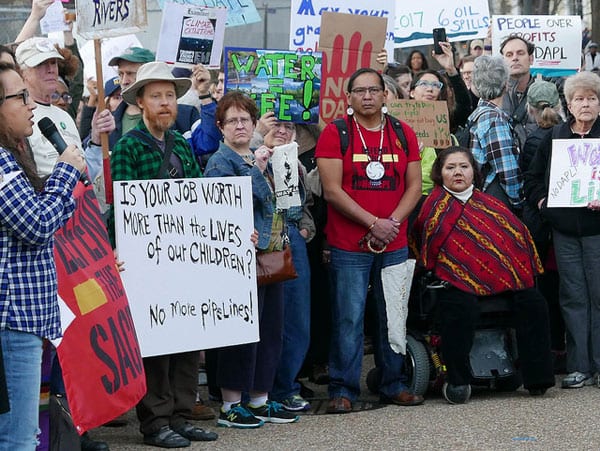
November 15, 2018; The Conversation
NPQ has discussed the issue of journalism with the goal of impact vs. clinical reportage of facts. Environmental journalists often walk the line between reporting—revealing truths—and advocacy, and they take risks akin to those reporting from dictatorships, wars, and disasters.
Tristan Ahtone, board member of the Native American Journalists Association, says it was apparent that reporters at the Standing Rock Indian Reservation in North Dakota protests against the Dakota Access Pipeline were taking a side. Reporters were arrested, too, in the sweep of protesters. But it happens around the world—journalists are arrested, harassed, and harmed. Between 2005 and 2016, 40 journalists were killed reporting on environmental issues worldwide. Fewer journalists were killed reporting from Afghanistan during the US war.
Environmental reporters stand between the public and businesses with large geographical economic interests, or corrupt and criminal organizations. Those groups have a great deal invested in preventing the public from knowing the truth, or from knowing unencumbered by corporate spin. The Committee to Protect Journalists (CPJ), a nonprofit, says, “Journalism plays a vital role in the balance of power between a government and its people. When a country’s journalists are silenced, its people are silenced.”
In 2013, independent journalist Rodney Sieh was sentenced to 5,000 years in prison in Liberia and a fine of $1.6 million for reporting that the former agriculture minister was involved in a scheme to misuse funds assigned to fight Guinea worm disease. Sieh served three months in the country’s worst prison before the global community pressured Liberia to release him. Miles Howe, a Canadian, covered protests by the Elsipotog First Nation in New Brunswick against fracking for natural gas. Howe was arrested many times, witnessed the violent arrests of protesters, and had his photography equipment seized and his home searched. He also reports he was offered money to spy on protestors.
Sign up for our free newsletters
Subscribe to NPQ's newsletters to have our top stories delivered directly to your inbox.
By signing up, you agree to our privacy policy and terms of use, and to receive messages from NPQ and our partners.
When future reporters are taught about the potential dangers of their profession, is there discussion of the aftereffects—the post-traumatic stress syndrome issues, the survivor’s guilt—that come along with physical injuries and scars? Eric Freeman, professor of journalism at Michigan State University and chair of the Knight Center for Environmental Journalism at the school, recently interviewed journalists on five continents for a study. His inquiries included how assaults, harassment, arrests, lawsuits, and self-exile affected the journalists. Freeman discovered that some became more passionate about their work, while others had to walk away from it. Sieh is the former, saying his time in prison “really elevated our work to an international level that we would never have had if I weren’t arrested. It made us stronger, bigger, better.”
“Overall, journalists are a pretty resilient tribe,” Bruce Shapiro, executive director of the Dart Center for Journalism and Trauma at Columbia University, told [Freeman]. “Their rates of PTSD and depression are about 13 to 15 percent, which is comparable to rates among first responders. Environmental or social justice reporters often have a higher-than-average sense of mission and purpose and a higher level of skill,” beyond that of some of their peers on other beats.
As with some military veterans, traumatized reporters may not seek help. Howe did not, for example, until a couple of years after he left journalism, and he regrets waiting. Are journalism professors and news editors aware of the dangers? Are they aware enough to provide training before assignments, and assistance after an assault?
Environmental dangers affect all—rural and urban, wealthy and poor, although those risks are by no means evenly distributed. Those who report on the problem should not end up becoming the story themselves. If environmental reporting is more dangerous than war reportage, then environmental reporters should be given as much preparation and training as war correspondents are.—Marian Conway











